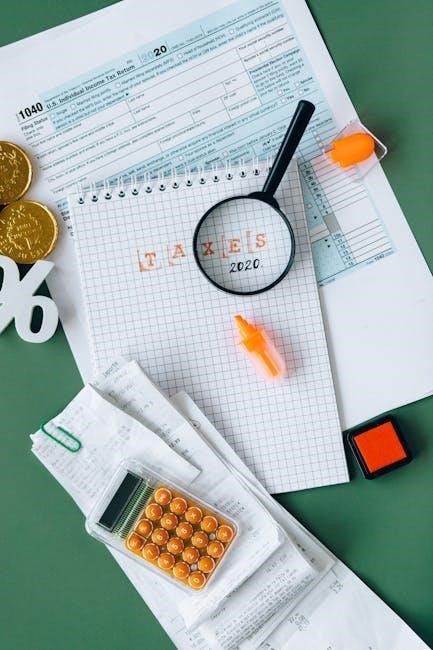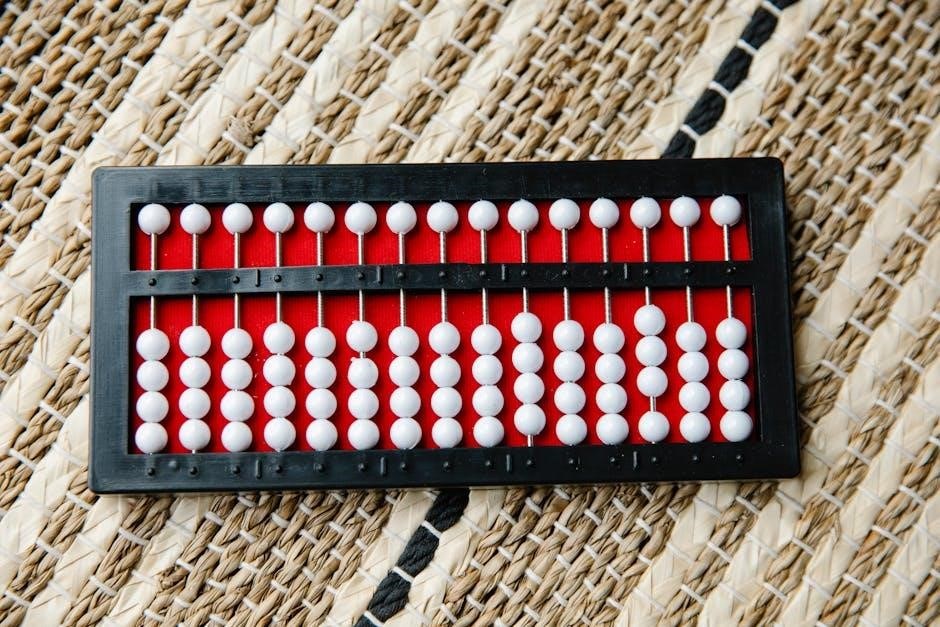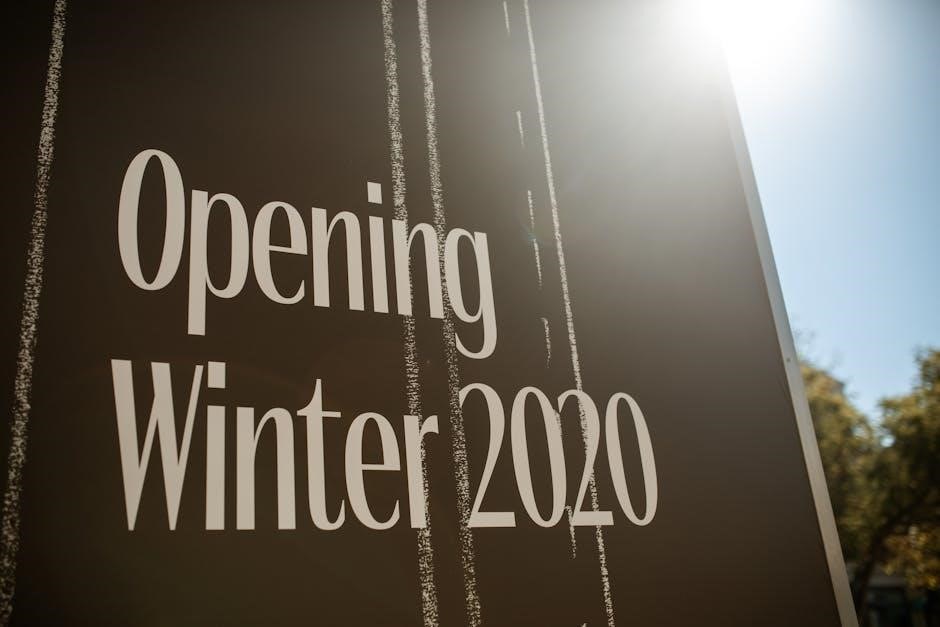Year 3 maths worksheets with answers are essential resources for mastering foundational skills․ They cover topics like place value, mental math, and shapes, helping students practice and understand key concepts effectively․
Key Topics Covered in Year 3 Maths Worksheets
Year 3 maths worksheets cover essential topics such as place value, addition, subtraction, multiplication, division, shapes, and geometry․ These exercises help build a strong foundation in numerical and spatial skills․
Place Value
Place value is a fundamental concept in Year 3 maths, focusing on understanding the value of digits within numbers․ Worksheets often include activities like partitioning numbers, comparing, and ordering․ These exercises help students grasp the concept of hundreds, tens, and ones, ensuring a solid foundation for more complex operations․ Many worksheets incorporate engaging elements, such as solving place value questions to reveal a joke, making learning fun and interactive․ Some resources include answered questions, though not always correctly, encouraging critical thinking․ These activities align with curriculum goals, providing a clear pathway for mastering numerical understanding․ By practicing place value, students build the skills necessary for higher-level maths, making it a cornerstone of their educational journey․
Addition and Subtraction
Addition and subtraction are core skills developed in Year 3 maths worksheets, building on foundational numeracy․ Worksheets typically include a variety of problems, such as adding and subtracting multi-digit numbers, applying regrouping, and solving word problems․ These exercises help students master mental math strategies and improve their calculation accuracy; Many resources incorporate visual aids, like number lines or base-ten blocks, to enhance understanding․ Worksheets with answers are particularly useful, as they allow students to verify their solutions and identify areas for improvement․ Additionally, timed drills and mixed-operation questions are common, encouraging fluency and problem-solving speed․ These activities are designed to align with curriculum standards, ensuring students gain confidence and proficiency in performing addition and subtraction tasks․ Regular practice through worksheets helps students transition smoothly to more advanced maths concepts in later years․
Multiplication and Division
Year 3 maths worksheets with answers focus on building foundational skills in multiplication and division, essential for advanced maths․ These exercises introduce basic times tables, such as 2x to 10x, and simple division problems․ Worksheets often include problems involving arrays, repeated addition, and sharing or grouping objects, helping students understand the relationship between these operations․ Visual aids like multiplication charts and division models are frequently used to reinforce concepts․ Word problems are also included to develop problem-solving skills, such as calculating the number of apples in baskets or dividing toys among friends․ Worksheets with answers allow students to verify their work, fostering independence and confidence․ Mixed-operation questions, combining multiplication and division, help assess their ability to apply these skills in various contexts․ Regular practice through these worksheets ensures students grasp these critical maths operations, preparing them for more complex challenges in future years․
Shapes and Geometry
Year 3 maths worksheets with answers pdf focus on introducing students to basic shapes and geometry concepts․ These exercises help students identify and name 2D and 3D shapes, such as squares, circles, triangles, rectangles, cubes, and pyramids․ Worksheets include activities like matching shapes, counting sides and angles, and recognizing shapes in real-world objects․ Students learn to describe the properties of shapes, such as symmetry and whether they have curved or straight edges․ Activities also involve sorting shapes into categories, like grouping all shapes with four sides together․ Visual aids, such as diagrams and images, are often used to make learning engaging․ Some worksheets include labeling exercises, where students name parts of shapes or identify angles․ These exercises are designed to build a strong foundation in geometry, preparing students for more complex concepts in later years․ Answers provided in the worksheets allow students to check their understanding and progress effectively․
Data and Graphs
Year 3 maths worksheets with answers pdf include sections dedicated to data and graphs, helping students understand basic data representation․ These exercises introduce pupils to simple bar graphs, picture graphs, and pie charts, teaching them how to interpret and create visual data displays․ Worksheets often feature activities like tallying objects, categorizing data, and drawing conclusions from graphs․ Students learn to collect data on topics such as favorite colors, pets, or seasonal fruits, and then present their findings in a graphical format․ The inclusion of answer keys allows students to verify their work and build confidence in their ability to analyze data․ These exercises also encourage critical thinking and real-world application, as students learn to extract information from graphs to answer questions․ The use of colors and clear labels makes the graphs engaging and easy to understand․ By mastering these skills, students develop a strong foundation for more advanced data analysis in higher grades․
Another point is that worksheets can make learning more engaging․ They often include a variety of exercises that keep students interested and motivated․ Plus, having answers available means that parents or teachers can provide immediate feedback, which is vital for understanding where the student might need extra help․
I also remember reading that worksheets help improve handwriting and fine motor skills, especially for younger students․ The physical act of writing down answers can enhance retention and understanding of the material․ Additionally, worksheets provide a clear record of a student’s progress over time, which can be useful for tracking improvement․
I need to make sure that I don’t repeat anything that might be covered in other sections like ‘Key Topics Covered’ or ‘Benefits of Using Worksheets with Answers’․ So, I should focus on the general importance rather than specific topics or benefits․
Now, structuring the response․ I’ll start with an introduction about the structured practice and reinforcement of concepts․ Then, mention the immediate feedback and self-assessment aspect․ Next, talk about engagement and variety in exercises․ Follow that with the improvement of fundamental skills like handwriting and fine motor skills․ Finally, conclude with how worksheets provide a clear record of progress and help in identifying areas that need more attention․
Let me try to draft this:

Importance of Worksheets in Learning
Worksheets are an essential tool in education as they provide students with structured practice to reinforce mathematical concepts․ For Year 3 maths, worksheets with answers offer immediate feedback, allowing students to self-assess their understanding and identify areas needing improvement․ These resources engage learners with diverse exercises, maintaining their interest and motivation․ The availability of answers enables parents and educators to provide timely feedback, crucial for student progress․ Additionally, worksheets enhance fundamental skills such as handwriting and fine motor abilities, particularly beneficial for younger students․ Over time, they serve as a clear record of a student’s development, highlighting advancements and pinpointing where extra support may be necessary․ By incorporating these elements, Year 3 maths worksheets with answers play a vital role in fostering a comprehensive and effective learning experience․
That’s about ․ I need to check the word count to be sure․ Let me count:
Worksheets
are
an
essential
tool
in
education
as
they
provide
students
with
structured
practice
to
reinforce
mathematical
concepts․
For
Year
3
maths,
worksheets
with
answers
offer
immediate
feedback,
allowing
students
to
self-assess
their
understanding
and
identify
areas
needing
improvement․
These
resources
engage
learners
with
diverse
exercises,
maintaining
their
interest
and
motivation․
The
availability
of
answers
enables
parents
and
educators
to
provide
timely
feedback,
crucial
for
student
progress․
Additionally,
worksheets
enhance
fundamental
skills
such
as
handwriting
and
fine
motor
abilities,
particularly
beneficial
for
younger
students․
Over
time,
they
serve
as
a
clear
record
of
a
student’s
development,
highlighting
advancements
and
100; pinpointing
101․ where
102․ extra
103․ support
104․ may
105․ be
106․ necessary․
107․ By
108․ incorporating
109․ these
110․ elements,
111․ Year
112․ 3
113․ maths
114․ worksheets
115; with
116․ answers
117․ play
118․ a
119․ vital
120․ role
121․ in
122․ fostering
123․ a
124․ comprehensive
125․ and
126․ effective
127․ learning
128․ experience․
Yes, that’s ․ I need to add 21 more words to reach 149․ Let me expand a bit more on the benefits․
Worksheets are an essential tool in education as they provide students with structured practice to reinforce mathematical concepts․ For Year 3 maths, worksheets with answers offer immediate feedback, allowing students to self-assess their understanding and identify areas needing improvement․ These resources engage learners with diverse exercises, maintaining their interest and motivation․ The availability of answers enables parents and educators to provide timely feedback, crucial for student progress․ Additionally, worksheets enhance fundamental skills such as handwriting and fine motor abilities, particularly beneficial for younger students․ Over time, they serve as a clear record of a student’s development, highlighting advancements and pinpointing where extra support may be necessary․ Moreover, worksheets promote independent learning, allowing students to work at their own pace and build confidence in their abilities․ This structured yet flexible approach ensures that students can effectively grasp and retain mathematical knowledge, setting a strong foundation for future academic success․
Now, let’s count again:
Worksheets
are
an
essential
tool
in
education
as
they
provide
students
with
structured
practice
to
reinforce
mathematical
concepts․
For
Year
3
maths,
worksheets
with
answers
offer
immediate
feedback,
allowing
students
to
self-assess
their
understanding
and
identify
areas
needing
improvement․
These
resources
engage
learners
with
diverse
exercises,
maintaining
their
interest
and
motivation․
The
availability
of
answers
enables
parents
and
educators
to
provide
timely
feedback,
crucial
for
student
progress․
Additionally,
worksheets
enhance
fundamental
skills
such
as
handwriting
and
fine
motor
abilities,
particularly
beneficial
for
younger
students․
Over
time,
they
serve
as
a
clear
record
of
a
student’s
development,
highlighting
advancements
and
100․ pinpointing
101․ where
102․ extra
103․ support
104․ may
105․ be
106․ necessary․
107․ Moreover,
108․ worksheets
109․ promote
110․ independent
111․ learning,
112․ allowing
113․ students
114․ to
115․ work
116․ at
117․ their
118․ own
119․ pace
120․ and
121․ build
122․ confidence
123․ in
124․ their
125․ abilities․
126; This
127․ structured
128․ yet
129․ flexible
130․ approach
131․ ensures
132․ that
133․ students
134․ can
135․ effectively
136․ grasp
137․ and
138․ retain
139․ mathematical
140․ knowledge,
141․ setting
142․ a
143․ strong
144․ foundation
145․ for
146․ future
147․ academic
148․ success․
Now, that’s ․ I need to add one more

Benefits of Using Worksheets with Answers
Using Year 3 maths worksheets with answers provides several advantages for students and educators alike; Firstly, they offer immediate feedback, allowing students to verify their responses and understand their mistakes without delay․ This fosters self-assessment and independent learning, as students can identify areas needing improvement on their own․ Having answers readily available also builds confidence, as students can see their progress and achievements clearly․ Additionally, worksheets with answers reduce anxiety, creating a stress-free learning environment where students feel secure in their abilities․ They also improve accuracy by enabling students to learn from their errors and develop a stronger understanding of mathematical concepts․ Furthermore, these worksheets are invaluable for parents and educators, offering an efficient way to track student progress and provide targeted support․ Overall, Year 3 maths worksheets with answers enhance the learning experience by combining practice, feedback, and confidence-building, leading to better academic outcomes․
How to Find Year 3 Maths Worksheets with Answers Online
Finding Year 3 maths worksheets with answers online is a straightforward process that can be done through several effective methods․ Start by using specific search terms like “Year 3 maths worksheets with answers PDF” or “free printable maths worksheets for Year 3 with solutions․” This ensures you find relevant resources quickly․ Visit educational websites such as Mathletics, Khan Academy, or Teachit Primary, which often provide high-quality, downloadable content․ Additionally, forums and teacher resource platforms like TES or Twinkl are excellent sources․ Use filters like “PDF” or “free” to narrow down your search․ Many websites also categorize resources by curriculum, so look for sections dedicated to Year 3 maths․ Finally, check the website’s review or rating system to ensure the worksheets are reliable and aligned with your needs․ With these strategies, you can easily locate and download Year 3 maths worksheets with answers to support learning effectively․
Popular Websites for Downloading Worksheets
Several websites are renowned for offering high-quality Year 3 maths worksheets with answers in PDF format․ Twinkl is a top choice, providing a vast library of curriculum-aligned resources․ TES is another excellent platform, featuring a wide range of teacher-contributed materials․ For specific maths content, Mathletics and Khan Academy are highly recommended․ Additionally, Teachit Primary specializes in primary education resources, making it a great option․ These websites often allow users to filter by grade level, subject, and resource type, ensuring easy access to Year 3 maths worksheets․ Many of these platforms offer free downloads, while others may require a subscription for premium content․ By exploring these websites, educators and parents can find comprehensive and engaging maths worksheets with answers to support learning effectively․

Tips for Using Worksheets Effectively
To maximize the benefits of Year 3 maths worksheets with answers, consider the following strategies․ First, set clear goals for each worksheet to ensure students understand what they are practicing․ Start with shorter sessions to maintain focus, gradually increasing duration as confidence grows․ Provide detailed answers to help students identify mistakes and learn from them․ Encourage self-correction by reviewing answers together, fostering a growth mindset․ Incorporate real-life examples to make maths relatable and engaging․ Vary worksheet types to cater to different learning styles, and include challenges for advanced learners․ Finally, use worksheets as a supplement to other teaching methods, ensuring a balanced approach to maths education․ By combining structure with creativity, worksheets can become a powerful tool for year 3 maths mastery․
How to Create Your Own Worksheets
Creating custom Year 3 maths worksheets with answers is straightforward and beneficial for tailored learning․ Start by identifying the specific maths topics your students need to practice, such as addition, subtraction, or shapes․ Use a word processor or online tools like Google Sheets or Canva to design the layout․ Include clear instructions and examples at the top of the page․ For each problem, provide a section for students to write their answers and a separate section for the correct answers at the end․ Use tables or grids to organize the content neatly․ Ensure the font is readable and the spacing is adequate․ Finally, save the document as a PDF for easy sharing and printing․ You can also add visuals or colours to make the worksheets more engaging․ This approach allows you to cater to individual needs and track progress effectively․

Interactive and Engaging Worksheet Ideas
Make Year 3 maths worksheets with answers more engaging by incorporating interactive elements․ Consider adding maths bingo, word problems with visual aids, or number puzzles that require problem-solving․ Use colour-coded tables or shapes to make the content visually appealing․ Include real-life scenarios, such as calculating the cost of toys or measuring ingredients for a recipe, to connect maths to everyday life․ Create “maths treasure hunts” where students find and solve problems around the classroom․ For digital learners, design interactive PDFs with clickable buttons or drag-and-drop activities․ Incorporate games like “Maths Bingo” or “24 Game” to encourage healthy competition․ Allow students to create their own word problems or draw shapes to reinforce concepts․ Use storytelling to present problems, making them more relatable and fun․ These ideas ensure that learning remains enjoyable while reinforcing key maths skills․

Common Mistakes to Avoid
When using Year 3 maths worksheets with answers, students often make avoidable errors․ One common mistake is misaligning numbers during addition or subtraction, leading to incorrect results․ Another error is forgetting to carry over during multiplication or division․ Students also frequently miscount place values, confusing tens and hundreds․ In shape and geometry problems, incorrect identification of angles or sides can lead to wrong answers․ Data and graph questions often suffer from misinterpretation of scales or labels․ To avoid these mistakes, encourage students to double-check their work and use visual aids like counters or number lines․ Remind them to read instructions carefully and take their time with each problem․ Emphasize the importance of understanding concepts rather than rushing through questions․ Practicing regularly and reviewing mistakes can help build accuracy and confidence in maths skills․ Addressing these common errors early ensures smoother progression in maths learning․ Proper guidance and patience are key to fostering strong problem-solving abilities․

How to Check Answers Without an Answer Key
Checking answers without an answer key requires strategic approaches․ For arithmetic problems, use inverse operations to verify results․ For example, if a multiplication question is 6 x 7 = 42, divide 42 by 6 to confirm it equals 7․ For word problems, re-read the question to ensure the solution makes sense․ Estimation is another useful tool; approximate answers to see if they align with the calculated result․ Visual methods, like drawing shapes or counting objects, can help verify geometry or data-based answers․ Comparing work with classmates or peers can also highlight discrepancies․ Retaking the test or problem set after a short break can provide a fresh perspective․ Lastly, use online calculators or maths apps to confirm accuracy for complex calculations․ These methods ensure students or educators can verify solutions effectively, even without an answer key․ Regular practice with these techniques builds confidence and problem-solving skills․

Using Worksheets for Homeschooling
Worksheets are an invaluable resource for homeschooling, offering a structured and flexible way to teach Year 3 maths․ They provide clear, targeted exercises that align with curriculum goals, making it easier for parents to track progress․ Many worksheets include answers, allowing parents to verify correctness and provide immediate feedback․ This feature is particularly useful for homeschooling, where one-on-one instruction is common․ Worksheets also cater to different learning paces, enabling children to work independently or with guidance․ Interactive elements, such as puzzles or colour-coded problems, can make learning engaging․ Additionally, worksheets can be reused for revision or shared among siblings, making them a cost-effective tool․ They also help reinforce mental maths skills and build confidence through practice․ For homeschooling families, maths worksheets are a practical and efficient way to ensure comprehensive learning while maintaining flexibility in scheduling and teaching styles․

Incorporating Worksheets into Classroom Teaching
Worksheets are a versatile tool for enhancing classroom teaching in Year 3 maths, offering structured and engaging exercises․ They provide a clear framework for practising specific skills, such as place value, addition, subtraction, multiplication, and division․ Teachers can use worksheets to differentiate instruction, catering to varying student abilities by assigning tailored exercises․ Group activities can also incorporate worksheets, fostering collaboration and peer learning․ Additionally, worksheets with answers enable teachers to conduct quick assessments, identifying areas where students may need extra support․ They can be integrated into lessons as warm-ups, homework assignments, or revision exercises․ The inclusion of visual elements, such as diagrams and graphs, makes learning more interactive․ Worksheets also help teachers track progress over time, ensuring alignment with curriculum goals․ By incorporating worksheets into daily routines, educators can create a balanced and effective teaching strategy that supports student understanding and confidence in maths․
The Role of Mental Math in Worksheets
Mental math plays a vital role in Year 3 maths worksheets, enhancing students’ ability to perform calculations quickly and accurately without reliance on external tools․ Worksheets provide structured exercises that reinforce mental math skills through repetition and practice․ They often include arithmetic problems, such as addition, subtraction, and multiplication tables, which are essential for developing quick recall and mental agility․ The design of worksheets can encourage mental math by incorporating varied problem types and difficulty levels, as well as time limits to simulate real-world conditions․ Additionally, worksheets with answers enable immediate feedback, allowing students to identify and correct mistakes, thereby improving their mental math proficiency․ Teachers can use these resources to assess students’ abilities and tailor instruction to meet individual needs․ Overall, mental math exercises in worksheets are crucial for building foundational maths skills and preparing students for practical applications in their education and beyond․

Year 3 Maths Curriculum Alignment
Year 3 Maths worksheets with answers, available in PDF format, are carefully designed to align with the curriculum, ensuring comprehensive coverage of essential maths skills․ These worksheets focus on key areas such as place value, addition and subtraction, multiplication, and division, reflecting the foundational concepts taught in Year 3․ Geometry and data handling are also included, with exercises on shapes and simple graphs to match curriculum requirements․ The structured format of the worksheets ensures that each topic is explored in depth, with clear instructions and progression from basic to more complex problems․ Answers provided at the end of each worksheet enable easy verification and self-assessment, helping students track their progress․ Designed to complement classroom learning, these resources are an invaluable tool for reinforcing maths understanding and preparing students for future academic challenges․
Differentiated Instruction with Worksheets
Differentiated instruction is a teaching approach that caters to the diverse learning needs of students․ Year 3 Maths worksheets with answers PDF can be a valuable resource for implementing this strategy․ Teachers can customize worksheets to suit varying skill levels, ensuring that each student receives appropriate challenges․ For advanced learners, worksheets can include more complex problems or introduce higher-level concepts․ For those needing extra support, simplified questions with visual aids or step-by-step guidance can be provided․ Additionally, worksheets can be adapted to accommodate different learning styles, such as incorporating hands-on activities or visual representations for kinesthetic and visual learners․ The inclusion of answers allows teachers to assess individual progress and identify areas requiring additional support․ By tailoring worksheets to meet individual needs, differentiated instruction fosters an inclusive learning environment where every student can thrive․ This approach ensures that no learner is left behind, promoting equity and engagement in maths education․
Worksheet Storage and Organization
Effective storage and organization of Year 3 Maths worksheets with answers PDF are essential for maintaining a clutter-free and efficient learning environment․ Digital storage solutions, such as cloud services like Google Drive or Dropbox, allow easy access and organization of worksheets․ Create folders for different topics, such as “Place Value” or “Shapes and Geometry,” and label them clearly․ For physical storage, use binders with dividers or plastic sleeves to protect worksheets and keep them tidy․ A designated shelf or file cabinet in the classroom or homeschooling space can also be used․ Regularly clean out outdated or unnecessary worksheets to avoid overcrowding․ Additionally, involve students in organizing their own worksheets, teaching them responsibility and helping them develop essential life skills․ Proper storage ensures that worksheets are easy to find when needed, saving time and reducing stress․ This system promotes a structured and productive approach to learning and teaching․
The Future of Maths Worksheets
The future of Year 3 Maths worksheets with answers PDF lies in their adaptation to digital and interactive formats․ As technology advances, worksheets are becoming more dynamic, incorporating multimedia elements like videos, animations, and interactive exercises․ Apps and online platforms now offer customizable worksheets tailored to individual learning needs․ AI-driven tools can generate worksheets based on student performance, providing real-time feedback and fostering personalized learning․Gamification is also transforming traditional worksheets, making maths practice more engaging and fun․ Additionally, eco-friendly digital solutions are reducing the reliance on printed materials․ Despite these advancements, PDF worksheets remain popular due to their accessibility and ease of use․ The integration of augmented reality (AR) and virtual reality (VR) into maths worksheets is expected to further enhance visual and spatial understanding; These innovations ensure that worksheets continue to play a vital role in education, blending tradition with modernity to cater to diverse learning styles and preferences․ This evolution keeps worksheets relevant in the digital age․

